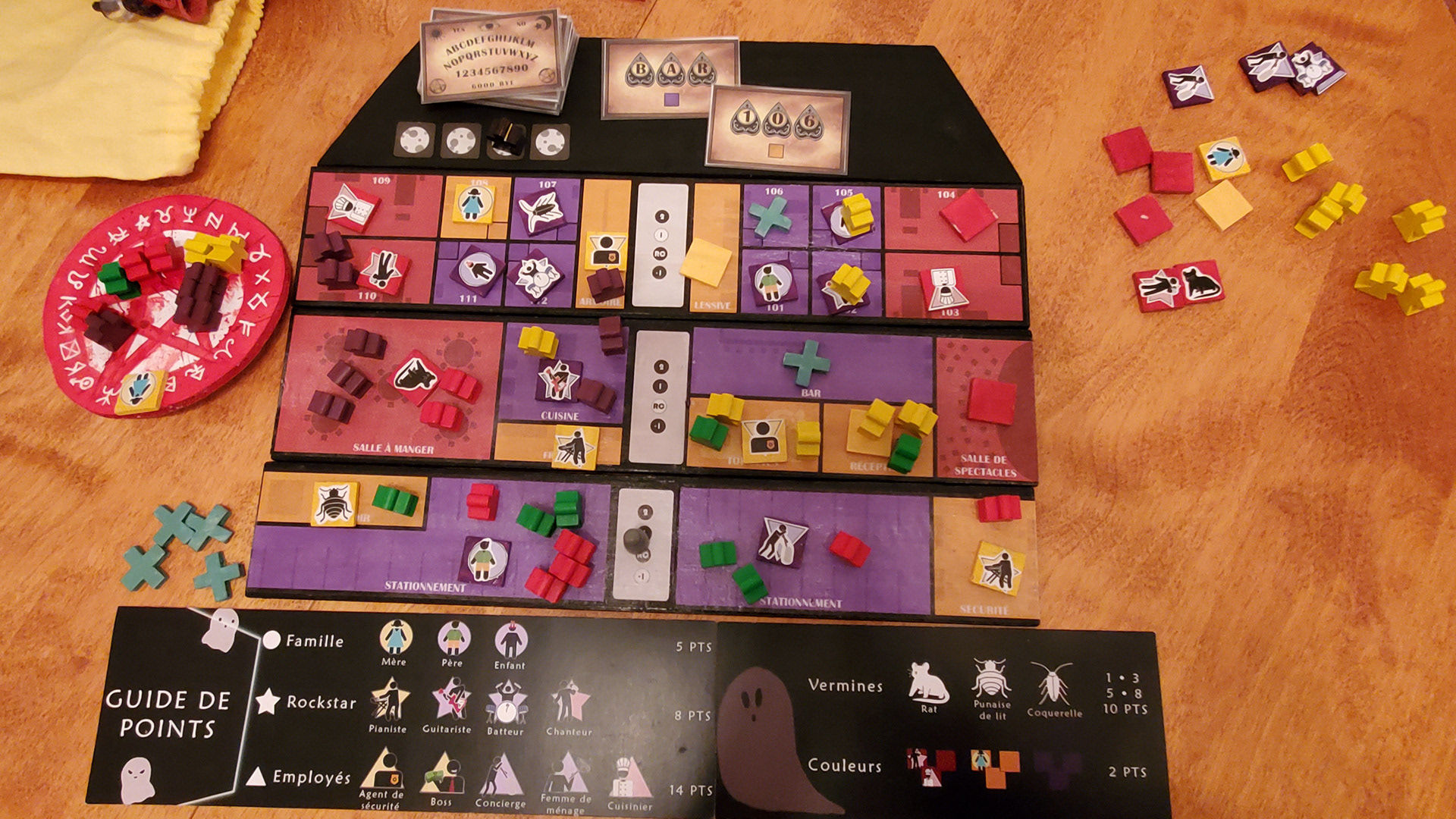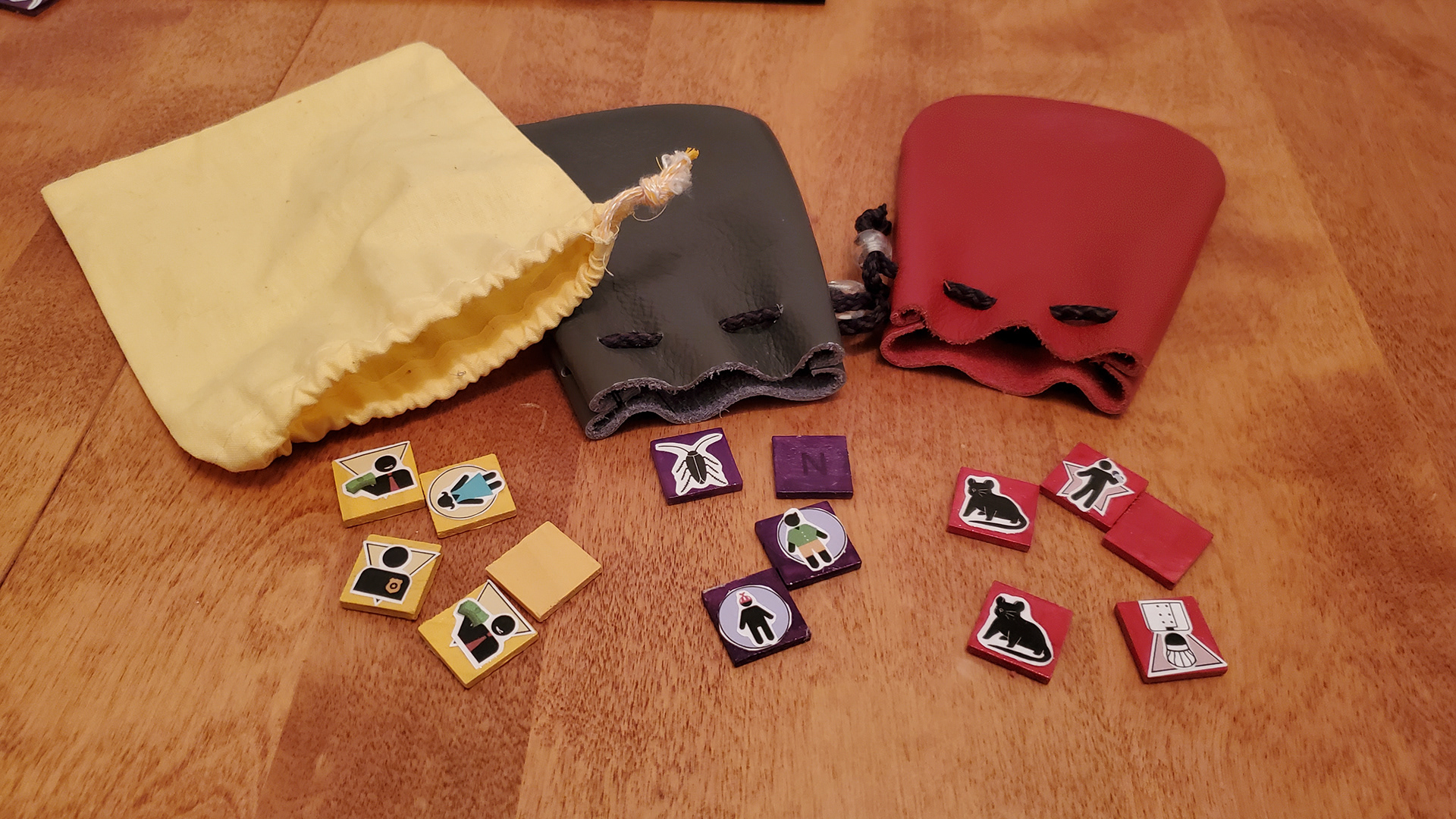
Sell Sheet

BOOked is a strategy game built around set collecting and area majority mechanics.
To win, scare the visitors and employees, haunt the hotel with your ghosts, and sacrifice them to gain the favours of Satan!
To win, scare the visitors and employees, haunt the hotel with your ghosts, and sacrifice them to gain the favours of Satan!
Create a trail of ectoplasm from room to room, possessing as many people as you can to score points. Sacrifice your ghosts to Satan to be the first or the last player to play the round, or to bet on humans. Distract the bellboy who tries to comfort them so you can access any floor your cold heart desires. Beware of the ghost hunter and the sage leaves he throws around!
This design project was created alongside two colleagues. We all designed the game, from the ideation phase to the materials, the instructions and the sell sheet. I was primarily in charge of the level design for the board in Photoshop and the sell sheet, but I also helped a little bit with the character art, and, most of all, participated in the design process equally with both of them.






SET COLLECTING
Set collecting is one of the main game mechanics that governs the game. It was a challenge to know how to create a set-collecting system that was satisfying and well balanced. Do we divide them by color? By category? How many will be available, and how many points are they worth?
We first chose to stick with 3 different sets, each made up of a different number of tiles (people to possess) and worth different numbers of point. This would allow players to risk more by trying to get bigger sets to get more points, or stick to the smaller ones and slowly but surely build their fortune.
We first chose to stick with 3 different sets, each made up of a different number of tiles (people to possess) and worth different numbers of point. This would allow players to risk more by trying to get bigger sets to get more points, or stick to the smaller ones and slowly but surely build their fortune.
Due to the ghost hunter leaving sage and blocking rooms, some tiles were getting more difficult to get or getting blocked off. This caused players to have a hard time completing their sets, and feeling the frustration of lost opportunities and not having half-points for half-completed sets. To remedy this, we added an "Errant Tiles" system, which would allow them to make a point for each remaining tile that did not fill a set.
Players were also getting confused by the point and tile system. We had initially introduced "Vermins" (rats, cockroaches and bedbugs) that could be stacked together to multiply points, and a colour grouping system. We wanted diversity to make the game more interesting and allow for different strategies, by allowing players to use the same tile to score points in different ways, but all of those along with the basic sets were getting confusing to players. We simplified everything by getting rid of rats and bedbugs, kept only the cockroaches, and switched the colour system with the Errant Tiles. We also forbid the players to use the same tile many ways to calculate the points in an easier and more consistent way.


The board
The board represents an hotel with its usual bedrooms and communal spaces. Because our design is very square and rectangular (as is normal for an hotel), we wanted it to be a little more dynamic and change during the game, to keep players on their toes and avoid predictability and monotony.
To solve this problem we introduced two mechanics: First is the ghost hunter. At the beginning of each round (except the first), the ghost hunter leaves sage in rooms to keep the ghosts away. This blocks the room for the rest of the game, forcing players to work around it and stop them from getting one more tile.
Second was the addition of the Bellboy. This pawn is there to protect the hotel's guests from the ghosts, and is positioned on the ground floor's elevator at the start of the game. When positioned on any floor, players cannot put their ghosts on said floor, but their can sacrifice three ghosts to Satan (in the Sacrificial Circle) to move it on a different level. This temporary tactic introduces a way to block your opponents, but also limits the current player at the same time, so must be used carefully.
Second was the addition of the Bellboy. This pawn is there to protect the hotel's guests from the ghosts, and is positioned on the ground floor's elevator at the start of the game. When positioned on any floor, players cannot put their ghosts on said floor, but their can sacrifice three ghosts to Satan (in the Sacrificial Circle) to move it on a different level. This temporary tactic introduces a way to block your opponents, but also limits the current player at the same time, so must be used carefully.
Player turns
A recurrent complaint from the players was the fairness of the game regarding the players' turn order. The first player usually has a disadvantage because after placing its booples first, their can be easily wiped out by the next ones. On the other hand, the last player needs to put on more booples to gain tiles already filled by the others, and is therefore restricted on the number of tiles it can play on.
Our first solution was to introduce the Sacrificial Circle, that contains 2 or 3 random tiles. When booples on the board are wiped out, their player can used them to gain tiles inside the Sacrificial Circle. This is a betting system that introduces new strategies for the players. They can chose to save their booples for the board or fight their opponents on the Sacrificial Circle.
In addition, we use it to let players chose their turn order at the beginning of each round. That way, the first doesn't always have to be first, and letting them choose their turn order themselves gives them more power and allows for different tactics.
In addition, we use it to let players chose their turn order at the beginning of each round. That way, the first doesn't always have to be first, and letting them choose their turn order themselves gives them more power and allows for different tactics.

Teammates